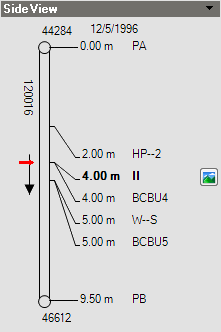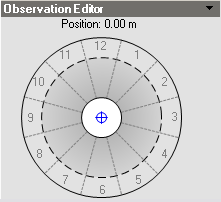Use the Inspection Editor to review imported information pertaining to specific sections of the wastewater network.
Inspection Editor Interface
The Inspection Editor interface is divided into three panes where you can review, edit and add observations.
- Tools Pane — On the left side; shows the tools for managing inspection observations.
- Image/Information Pane — On the right side; shows the inspection video along with descriptive information about the video content.
- Inspection/Video Controls Pane — Across the bottom; controls the video and selection of primary and secondary inspection data.
Inspection Editor Menus
There are several menus included in the Inspection Editor.
|
Menu |
Description |
Toolbar Icon |
|---|---|---|
|
Section |
Open Report—Displays an inspection report for the current section. The report is displayed in a secondary window. You can print the report or change its format to HTML, ASCII, or PDF. |
|
|
Observation |
Create Point Observation—Allows you to create an observation instance occurring at a specific point in the section. |
|
|
|
Create Lateral Observation—Allows you to create an observation instance occurring somewhere around the circumference of the section. |
|
|
|
Create Longitudinal Observation—Allows you to create an observation instance occurring along the length of the section. |
|
|
|
Auto Zoom—Automatically zooms to a selected inspection observation. |
|
|
|
Auto Highlight—Automatically highlights the selected inspection observation. |
|
|
Video |
Play/Pause—Starts or pauses the video. |
|
|
Stop—Stops the video. |
|
|
|
Fast Forward—Speeds up video. |
|
|
|
|
Rewind—Rewinds the video. |
|
|
|
Next—Advances the video by one frame so you can more accurately perform inspections. |
|
|
|
Previous—Backs the video up by one frame. |
|
|
Dock (icon) |
In/Out—An icon at the right-hand side of the menu that controls whether the Inspection Editor is docked with the form or whether it is undocked. When undocked, you can still view the Inspection Editor and choose other tabs in the form. |
|
Tools Pane
The Tools pane is divided into four sections; Tools, Side View, Description and Observation Editor.
| Tool Pane Section | Description |
|---|---|
|
Tools |
The Tools section contains several icons that duplicate some of the functionality found in the Section and Observation menus. You can choose to enable or disable automatic zoom and highlight, or you can open a report for inspection. At the right side of the Tools section is an icon you can use to collapse or expand the Tools pane. If you click the Open Report button, the inspection report is displayed in a secondary window. You can print the report or change its format to HTML, ASCII, or PDF. |
|
Side View  |
The Side View section displays a graphical representation of an inspected section of pipe between a from manhole and a to manhole along with their unique feature IDs. Note: The ‘from manhole’ is always at the top of the side view.
To the left of the section representation is an arrow which indicates flow direction. To the right of the section representation is a list of distances and corresponding damage codes. Double-clicking a damage code changes the description data shown in the Description section and also advances or rewinds the video to that location along the section. If an image icon is present, it means there is a still image associated with that observation point which you can view. Note: If multiple observations are within 2 meters of one another, double-clicking or moving the slider over one of the observations with auto-highlight or auto-zoom all the observations. This occurs only when Auto Highlight or Auto Zoom are active.
Hovering the cursor over a damage code displays a menu where you can choose to highlight or zoom to the damage, open a form, delete the damage observation, or fix the damage observation. Navigating the red arrows in the side view to different damage observations will also advance or rewind the video display to the selected observation.
|
|
Description  |
The Description section contains information regarding the currently selected damage observation. You can find the following information:
|
|
Observation Editor  |
The Observation Editor section contains a graphical representation of the inside of the inspected section looking from the ‘from manhole’ toward the ‘to manhole’. The observation editor is further delineated by twelve wedges representing positions on a clock. Observations in the observation editor are depicted as follows:
|
Image/Information Pane
The Video/Information pane displays the inspection video that was imported along with the other inspection data. Along with the video, inspection and section data related to the video is displayed, such as a description of where the video was shot, the data the inspection team recorded the video, what the section of pipe is made of and how big it is.
The video is synchronized with the documented observations noted in the Side View section of the Tools pane. This means that if you played the video and notice damage 3 meter into the section, there is likely to be a damage observation called out in the Side View.
Inspection/Video Controls Pane
The Inspection/Video Controls pane allows you to select the main and secondary inspections with which you want to work. A main inspection is always needed, but the secondary inspection is set to “None” by default. You can open the secondary inspection list and select a secondary inspection. The secondary inspection is displayed beside the main inspection in the side view where you can perform a side-by-side comparison of the two inspections. Using a secondary inspection does not advance or rewind a video file, if one is loaded.
The video control buttons beneath the video display duplicate the controls in the Video menu. When using the controls while reviewing inspection observations, you can play, pause, stop, fast forward or rewind the video. You can also move frames forward or back one frame at a time to more accurately inspect video content.
If you only want to review video of the inspection data, you can use the Inspection Editor Web. The web version displays a video window with playback controls and an inspection list where you can choose the specific inspection data you want to view.
AutoCAD Map 3D toolset uses the Windows Media Player for video playback which supports WMV and MPG file formats. Infrastructure Application Extension uses the Microsoft® SilverLight™ player which only supports WMV video files.